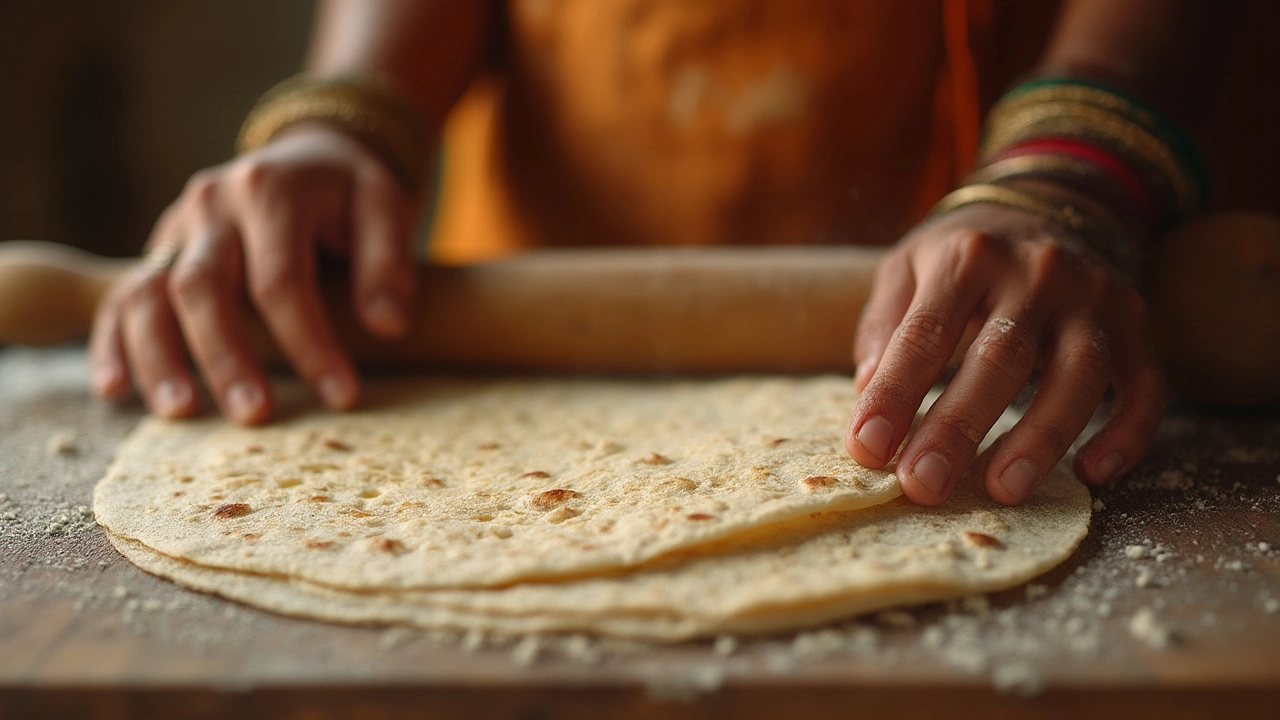Some families can’t agree: should roti be thick or thin? This question is more explosive at the dinner table than how spicy your curry should be. With a history as old as the wheat fields where it’s born, roti has become more than just food. It’s the silent star of Indian cuisine, gracing plates in every state, village, and city. Yet, the thickness of that humble disk of flour is the quiet heart of Kitchen Wars everywhere. So, let’s settle this once and for all. Is there a right or wrong way to roll roti?
The Science and Art of Roti Thickness
Let’s get real: the thickness of roti totally changes your eating experience, and it’s not just about looks. Thin rotis, rolled out to almost paper-like delicacy, cook super fast and puff up beautifully on the tawa or even straight on the flame. There’s this moment, that gorgeous ballooning, where you can see steam dancing inside—a sign of expert hands and the right dough consistency. But thin roti isn’t just fancy showmanship; it’s got a purpose. Thin rotis soak up gravies and side dishes faster. That means the flavors flood your mouth with every bite, and the bread doesn’t overpower the main star on your plate.
Thicker rotis are all about chew and comfort. They’re often a little softer inside, rugged on the outside. In colder regions like Punjab or for heavier meals, thicker rotis help soak up richer, oilier curries and hold together without becoming soggy. Grandma’s trick? A slightly thicker roti paired with a pat of ghee keeps your belly full during a workday in the fields or a long day at school. If you eat something like sarson da saag or rajma, a thick roti stands up to the challenge—no wilting, no mess.
Here’s a fun detail you might not know: In Bengal and Odisha, a thin chapati (“phulka”) is the norm. But in Gujarat, thick “rotlas” and “theplas” are the deal—hearty, almost like a meal on their own. There’s serious geographic personality at play. And you know what? Even nutrition reacts to thickness. A thinner roti is often a tad less caloric—less mass, less wheat, less of everything except that lovely toasty flavor. Thicker versions, especially the jumbo bajra or jowar rotis of Western India, give you long-burning fuel and pack more fiber.
Beyond taste and texture, thickness impacts cooking time—a thinner roti takes maybe 30 seconds per side, while a thick one might need two minutes each. Mess up, and a thick roti turns doughy inside, a thin one burns in a flash. This is truly the dance of dough, fire, and skill. Get the ratio right, and you’ll feel like a kitchen champion.
| Roti Thickness | Cooking Time (per side) | Calories (avg per piece) | Best For |
|---|---|---|---|
| Thin (1-2mm) | 30-40 seconds | 70 | Light meals, gravy dishes |
| Medium (2-3mm) | 40-60 seconds | 90 | Everyday use |
| Thick (4mm+) | 90-120 seconds | 110 | Hearty curries, travel food |

Regional Wars, Family Traditions, and Street Secrets
Open the kitchens of India, and you’ll find that roti thickness is as much about where you’re from as how you cook. Travel to Rajasthan, and thick bajra rotis rule, rolled by hand and cooked on a clay tawa. Up north, Punjab’s parathas disguise themselves as fat rotis stuffed with potatoes or paneer, oozing with ghee. There’s even a funny saying in Hindi, "Punjab di roti, ghee vich khoti"—which means roti from Punjab is drowned in ghee. In contrast, you go to Maharashtra and Gujarat, and you’ll discover the gentle thinness of phulkas or rotlis, always perfectly round and soft, eaten with simple sabzi or dal.
This battle plays out at tea stalls and home buffets everywhere. Street vendors in Mumbai whip out wafer-thin chapatis, perfect for wrapping spicy keema or egg. Meanwhile, a Sunday lunch in a Bengali home could feature phulkas, rolled practically transparent, then puffed and served with a ghee brushing. What about South India? The typical "roti" is actually parotta, thicker and flakier. But wheat chapati has started sneaking into menus, usually on the thinner side, as health trends grow.
If you stay long enough in any Indian town, someone’s Nani or Dadi will insist their way is the only way. One survey by an Indian food magazine in late 2023 spotted a wild split among readers—48% said they preferred their roti medium-thick, 38% went with thin, and just 14% swore by thick rotis. Funny thing—region made less difference than whether someone grew up eating roti at home or in school or college. Turns out, habit trumps geography.
Let’s not skip travelers. For packed lunches, thick rotis wrapped with chutney, jaggery, or pickle are the survival hack of road trips across India. Why? Thick roti doesn’t dry out fast. They last longer, soak up less moisture, and stay soft. Street-food hawkers selling kathi rolls, on the other hand, roll out thin, almost translucent rotis to get that perfect crunch and wrap. There’s a method to every madness.
Ever noticed how butter behaves on a thick versus thin roti? Thick ones create a fluffy, pillowy landing for melting spreads, while a thin roti lets every bit seep into the bread, flavoring it edge to edge. Even reheating tells you something: thick rotis bounce back with a touch of steam, while thin ones need careful handling or they'll go crisp.
Let’s not forget festive specials. During Rajasthani Teej or Gujarati festivals, you’ll find thick rotis adorned with seeds and slathered in ghee. In central India, thin rotis are used as the base for heavenly dal baati—crunchy balls of baked dough dunked in dal, then scooped up with a thin, slightly charred roti. So thickness isn’t just tradition—it’s tailored to the meal, the occasion, even the weather outside.

How to Decide: Tips and Tricks for Rolling the Perfect Roti
Forget the pressure to “do it right.” The perfect roti thickness is really the one that fits your taste, your skill with the rolling pin, and what’s for dinner. Still, there are easy hacks and classic chef secrets that can tip the scales in your favor. Want that soft, cloud-like thick roti? Use slightly more water and a touch of ghee in your dough. Let the dough rest at least 30 minutes before rolling; this lets the gluten relax, making it easy to roll thicker without cracking the dough.
For roti thickness perfection, here’s a hack: When making thin rotis, use only enough flour to dust the dough while rolling. More flour dusting tends to toughen the surface and dry out thin rotis during cooking. Roll with a light hand, spinning the dough in quarter turns for evenness, and keep your pressure closer to the center, easing off the edges. If you’re aiming for super-thin, try rolling between sheets of parchment. It might feel like cheating, but it guarantees a delicate round.
Not sure what thickness works for you? Run this quick test: Hold your raw, rolled roti up to the light. If you can just see your hand’s silhouette, that’s thin. If not, you’re in the thick camp. Later, as it hits the heat, keep your eyes peeled. Thin rotis puff instantly, and you want to flip fast. Thick rotis need gentle, longer heat; press down with a cloth or spatula so the middle cooks through without burning the surface.
Don’t let perfectionism kill the fun. Each roll is a mini adventure—you’re allowed to mess up. In fact, here’s a pro move: intentionally try both thicknesses in one meal and let your taste buds decide. One friend of mine, a Mumbai chef, always does a thin roti for breakfast (with honey or sugar for dipping) but prefers fat, thick ones for late dinners.
If you’re dealing with leftovers, thin rotis are great for making wraps, even next-day quesadillas or chips. Thick roti leftovers? They hold up in lunchboxes, reheated (with a splash of water on top), or used to scoop up runny curries. Hungry for dessert? Smear with ghee and jaggery, roll up, and microwave for a minute—instant sweetness, thick or thin.
Want to add a twist? Mix the atta (wheat flour) with millet or corn for firmer, thicker rotis that last longer and keep you full. Or blend in mashed spinach for color and nutrients, thin or thick. The whole point: don’t let rules and tradition rob you of the adventure. Gather family or friends, roll together, mess up, and laugh. Even the wonkiest roti is still bread—soft, hot, and ready to carry whatever story or flavor you love.
